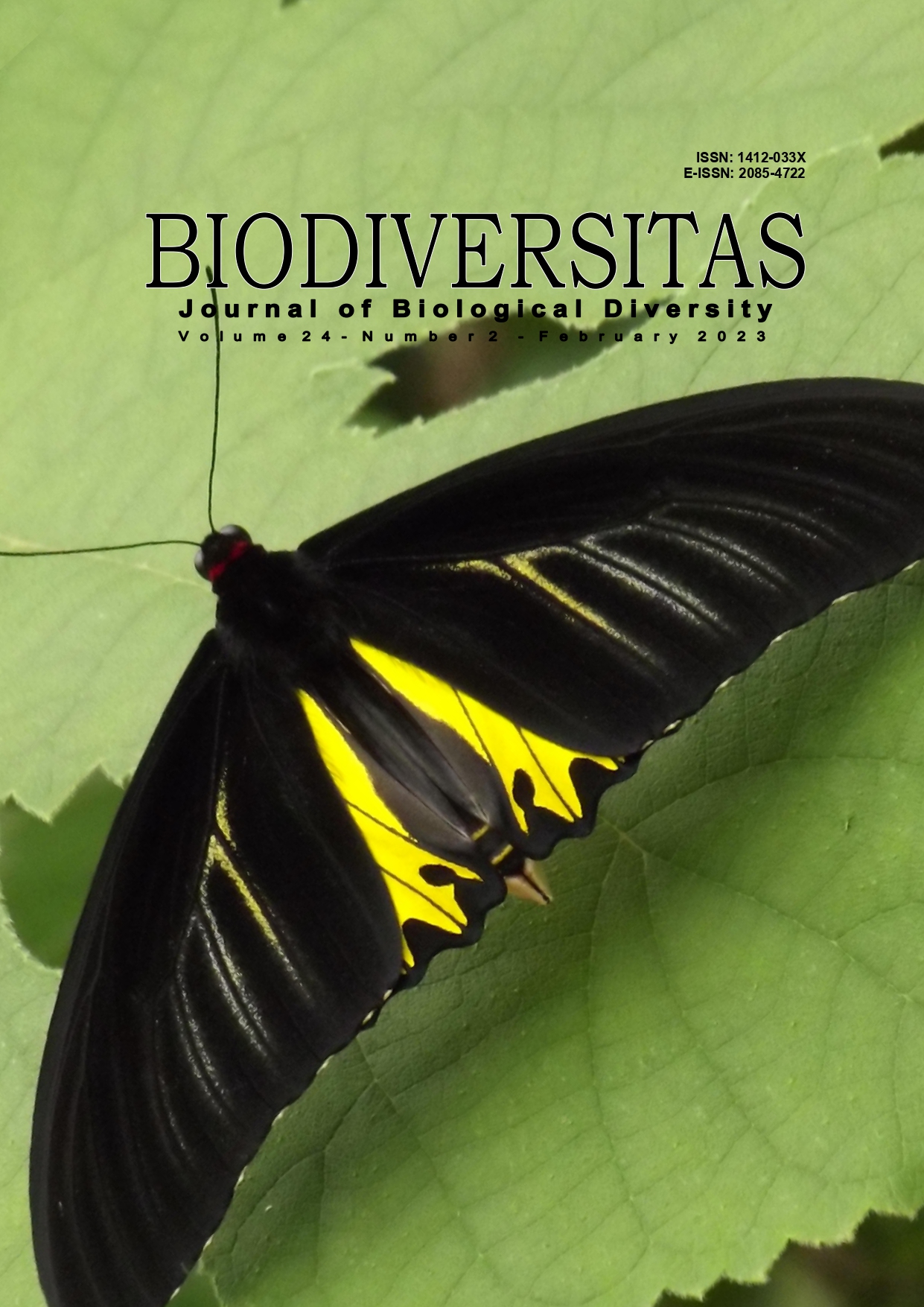Short Communication: The flowering process of Prunus cerasoides Buch.-Ham. Ex D.Don in Bali Botanic Garden
##plugins.themes.bootstrap3.article.main##
Abstract
Abstract. Oktavia GAE, Iryadi R, Warseno T, Purnobasuki H. 2023. Short Communication: The flowering process of Prunus cerasoides Buch.-Ham. Ex D.Don in Bali Botanic Garden. Biodiversitas 24: 1186-1191. Prunus cerasoides Buch.-Ham. Ex D.Don is a native plant of the Indian-Indochinese floristic zone and one of the Eka Karya Bali Botanical Gardens' collection plants (EKBBG). Weather factors have an impact on the length of blossoming. Moreover, the microclimate variations study is a fascinating subject. A plant's adaptation is influenced by changes in the environment regularly. This research goal was to figure out how P. cerasoides flowers in EKBBG and how that relates to environmental parameters. The flowering time of four P. cerasoides trees from the EKBBG collection was observed. The weather from satellite data of the EKBBG Registration Unit provided environmental data in the form of air temperature, humidity, air pressure, and rainfall. The IBM SPSS Statistics 23 software was used to analyze the data. The results revealed that P. cerasoides in EKBBG flower twice a year, with the development stage of flower buds, blooming, and then the fall phase of the floral ornaments. Due to the blossoms falling, the fruit did not mature. Moreover, the number of blooms that develop is unaffected by temperature or UV index.
##plugins.themes.bootstrap3.article.details##
Most read articles by the same author(s)
- SERAFINAH INDRIYANI, ENDANG ARISOESILANINGSIH, TATIK WARDIYATI, HERY PURNOBASUKI, A model of relationship between climate and soil factors related to oxalate content in porang (Amorphophallus muelleri Blume) corm , Biodiversitas Journal of Biological Diversity: Vol. 12 No. 1 (2011)
- FITRIA ARDIYANI, EDY SETITI WIDA UTAMI, HERY PURNOBASUKI, SENJA APRILIA PARAMITA, Development and regeneration of somatic embryos from leaves-derived calli of Coffea liberica , Biodiversitas Journal of Biological Diversity: Vol. 21 No. 12 (2020)
- MOCHAMMAD ILHAM, SITI RIZQIYATUL MUKARROMAH, GALUH AYU RAKASHIWI, DANI TRI INDRIATI, BRUNI FLARANDA YOKU, PUTUT RAKHMAD PURNAMA, JUNAIRIAH, SEHANAT PRASONGSUK, HERY PURNOBASUKI, DWI KUSUMA WAHYUNI, Morpho-anatomical characterization and DNA barcoding of Achillea millefolium L. , Biodiversitas Journal of Biological Diversity: Vol. 23 No. 4 (2022)
- SUTOMO, I DEWA PUTU DARMA, RAJIF IRYADI, Short communication: The dissimilarity in plant species composition of savanna ecosystem along the elevation gradient on Flores Island, East Nusa Tenggara, Indonesia , Biodiversitas Journal of Biological Diversity: Vol. 21 No. 2 (2020)
- SUTOMO, RAJIF IRYADI, I DEWA PUTU DARMA, I PUTU AGUS HENDRA WIBAWA, AYYU RAHAYU, SITI FATIMAH HANUM, SYAMSUL RIZAL, LEDYA NOVAMIZANTI, JANGKUNG RAHARJO, Short Communication: Plant diversity utilization and land cover composition in the Subak Jatiluwih, Bali, Indonesia , Biodiversitas Journal of Biological Diversity: Vol. 22 No. 3 (2021)
- SUTOMO, EDDIE VAN ETTEN, RAJIF IRYADI, Short communication: Savanna-forest boundary on Mount Rinjani, Lombok Island, West Nusa Tenggara, Indonesia , Biodiversitas Journal of Biological Diversity: Vol. 22 No. 2 (2021)
- SUTOMO SUTOMO, I DEWA PUTU DARMA, ARIEF PRIYADI, RAJIF IRYADI, Short Communication: Trees species diversity and indicator species in Bedugul forest ecosystem, Bali, Indonesia , Biodiversitas Journal of Biological Diversity: Vol. 19 No. 6 (2018)
- HERY PURNOBASUKI, GALUH AYU RAKHASHIWI, JUNAIRIAH, DWI KUSUMA WAHYUNI, RAMADHANI EKA PUTRA, RIKA RAFFIUDIN, RC HIDAYAT SOESSILOHADI, Morpho-anatomical characterization and DNA barcode of Cosmos caudatus Kunth. , Biodiversitas Journal of Biological Diversity: Vol. 23 No. 8 (2022)
- RAMADHANI EKA PUTRA, GUNAWAN WIBISANA, IDA KINASIH, RIKA RAFFIUDIN, RC HIDAYAT SOESILOHADI, HERY PURNOBASUKI, Pollination biology of yellow passion fruit (Passiflora edulis forma flavicarpa) at typical Indonesian small-scale farming , Biodiversitas Journal of Biological Diversity: Vol. 24 No. 4 (2023)
- TRI WARSENO, MUHAMMAD EFENDI, ABDUL RAZAQ CHASANI, BUDI SETIADI DARYONO, Genetic variability and phylogenetic relationships of Begonia multangula based on atpB-rbcL non-coding spacer of cpDNA sequences , Biodiversitas Journal of Biological Diversity: Vol. 23 No. 10 (2022)

